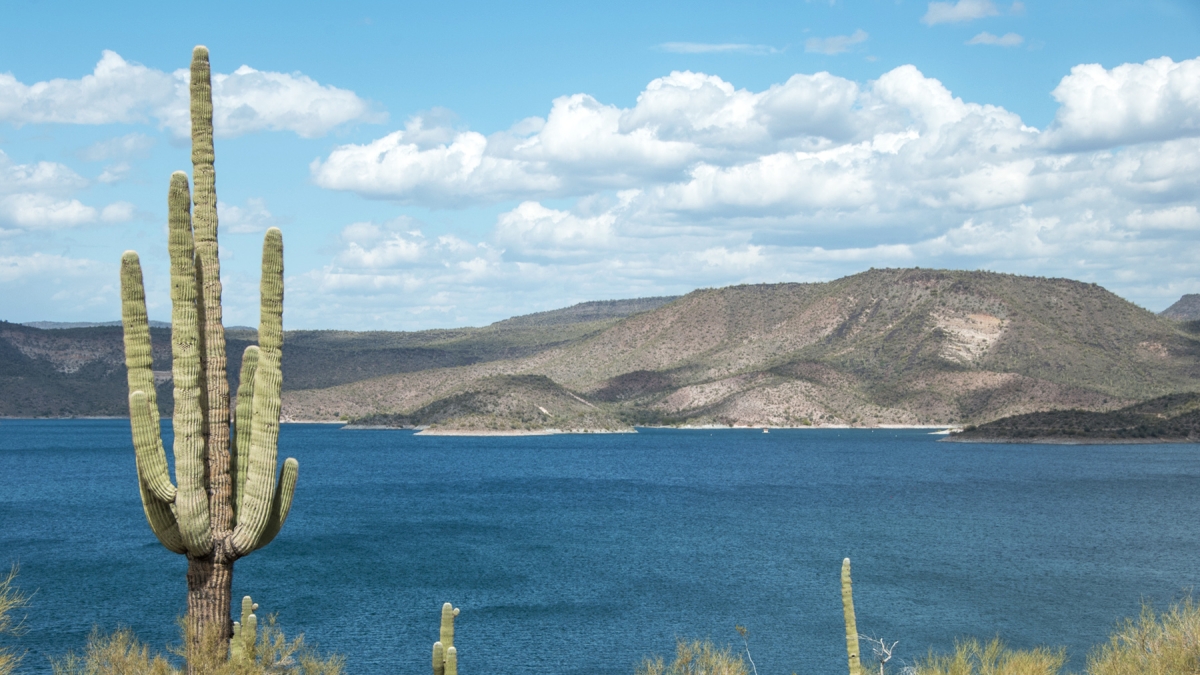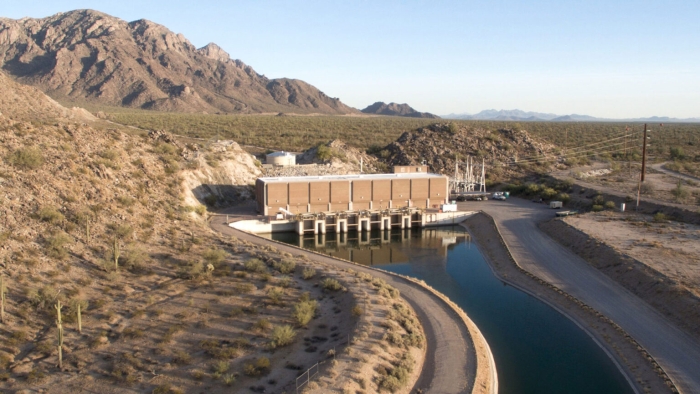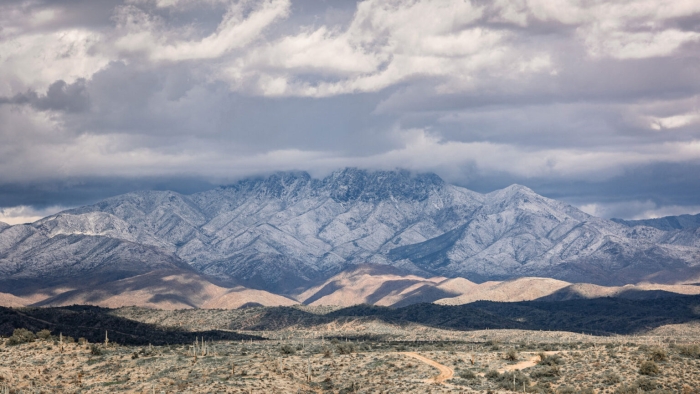Climate change raises challenge to secure vital resource

Lake Pleasant (pictured), located north of Phoenix, serves as the Central Arizona Project’s water storage reservoir, as well as being a popular recreational amenity. Water shortages are impacting Colorado River Basin reservoirs such as Lake Mead in Nevada and Lake Powell, which stretches across northern Arizona and southern Utah. Environmental changes throughout the Southwest are presenting challenges to maintaining flows. Photo courtesy of Central Arizona Project
“Water is life’s matter and matrix, mother and medium. There is no life without water.”
So said Albert Szent-Györgyi, a 1937 Nobel Prize-winning medical expert whose research helped bring us the benefits of vitamin C. His statement accentuates one of the most critical requirements for health and prosperity: reliable sources of water.
Today, continued technological advances are needed to ensure this goal can be achieved even while facing significant environmental challenges that pose a threat to the future of essential water resources.
One major focus of such an endeavor is the Colorado River Basin, on which Arizona and six other states in the U.S. Southwest — California, Colorado, Nevada, New Mexico, Utah and Wyoming — and a sizable swath of neighboring Mexico depend heavily for water supplies.
A recent article in the Water Resources Research international hydrology science journal, “On the Sensitivity of Future Hydrology in the Colorado River to the Selection of the Precipitation Partitioning Method,” reports that expected smaller snowpack levels will reduce the basin’s streamflows to seriously problematic low levels.
Four of the five contributors to the research paper are part of a team from Arizona State University’s Center for Hydrologic Innovations, directed by Enrique Vivoni, Fulton Professor of Hydrosystems Engineering in the School of Sustainable Engineering and the Built Environment, part of ASU’s Ira A. Fulton Schools of Engineering.
The paper reports on results of the team’s hydrologic simulations and analysis of the implications for future water projections in the Colorado River Basin and other mountainous basins due to warming temperatures triggered by climate change that can shift snowfall to rainfall, potentially reducing resulting water levels.
The team’s work has resulted in the development of models of the conditions in the basin, which covers an area of about 250,000 square miles. The findings can be used to forecast the future water supply to help guide public policymakers’ decisions on managing the use of available water supplies.
Solutions needed to stave off severe future droughts
The project builds on many years of collaborations with the Central Arizona Project, or CAP, the water and infrastructure management agency in charge of delivering Colorado River water to central and southern Arizona. It’s also supported by grants from NASA in collaboration with CAP to develop a forecast of the potential effects of future droughts in the Colorado River Basin.
“In the middle of these projects comes an important declaration of water shortage, which is occurring due to the drought, and that triggered a lot of angst in the state of Arizona, and in other states, and it has forced CAP to reduce its water deliveries for several years now,” Vivoni says.
“We’re trying to help CAP anticipate what the Colorado River will look like in the future, 20 years from now and 100 years from now, because water agencies need to start adapting management to a new reality and communicating this to those sectors in Arizona that depend on its water supply,” he says. “This includes farmers, cities and tribes, so it affects the entire state’s economic activity.”
Other issues that need to be resolved include how priorities will be established for various interests in the future so that there are no inequities in the allocation.
Researchers are planning studies to learn more precisely how water shortages have impacted farmers in central Arizona. Those insights could help farmers cope with long drought periods, such as transitioning to growing different crops that use less water or using groundwater instead of surface water, and to take steps to ensure that the burden of reduced water availability will be equally shared.
“The shortages the region is dealing with now are small relative to those that we will have to deal with as warming continues,” Vivoni says. “This is happening throughout the Colorado River Basin where warmer climates will impact snowfall and snowpack amounts, reducing streamflow,” Vivoni says. “It leads to more snow going into the atmosphere and not into the soil.”
He adds that the precipitation outlook in the Colorado River Basin is a bit less certain. Some forecasting models indicate a wetter future. Other models say it will be a drier future. Overall, there might be long dry sequences or wet sequences lasting years or decades in the future.
“We have found that even in cases where the future is wet, this additional precipitation does not overcome the effects of warmer temperatures that lower streamflows,” Vivoni says.
This understanding is crucial as water management becomes an increasingly pressing issue in the Colorado River Basin.
“It is well known that the U.S. states that share the Colorado River will need to renegotiate the rules of how water shortages are allocated. Then they need to work with Mexico to figure out similar shortage rules among the countries,” he says. “The work we’re doing is feeding this discussion. The concept of how a river basin such as the Colorado River might work in the future is being transmitted to the people who are involved in this decision-making process.”
Myriad collaborations required to ensure long-term progress
“Since there is significant interest in understanding how the river basin works, many researchers are developing techniques to tackle this problem in different ways,” Vivoni says. “As a result, we have a large group of stakeholders and other interested partners with whom we need to frequently communicate.”
Among key people in that network is Nolie Templeton, for whom Vivoni served as an advisor during her studies to earn a doctoral degree in civil, environmental and sustainable engineering at ASU. She is now one of the CAP’s Colorado River programs planning analysts and provides technical support for water policy managers and decision-makers.
“We’re very focused on incorporating the best available climate science and hydrological observations and operations into our plans for use of water supplies,” Templeton says. “So the partnership with ASU is very beneficial. This is a group that we can meet with in person to talk about ideas or science concepts.”
Through the ASU collaboration, for instance, Templeton notes that CAP is benefiting from access to NASA satellite data. With such information to guide policy decisions, Templeton says CAP can feel more confident about developing policies that will provide robust defenses against the challenge of a future with a drier climate.
Among others who have participated in the research and co-authored the research paper is Kristen Whitney, an ASU geological sciences doctoral graduate who is now a postdoctoral fellow and hydroclimate data scientist with NASA’s Goddard Space Flight Center.
“We’re trying to bridge the gap between these advanced technologies and the data our water managers have access to and how they can use that in making their decisions,” Whitney says.
Her work could aid ASU’s efforts by improving land surface models that have long been used by the U.S. Bureau of Reclamation as she develops similar tools specifically designed to provide more robust satellite data that produces enhanced land surface modeling.
Called the North American Land Data Assimilation System, this specific tool is designed to provide data on both land surface and meteorological conditions in real time that is more useful to researchers, water managers and policymakers, and other government agencies.
“This will use satellite data to investigate drought impacts on agriculture across the Western U.S. to come up with metrics that are helpful for decision-makers,” Whitney says.
Whitney has also developed a web-based tool to help water managers access ongoing results of the Colorado River research performed at ASU.
What’s learned from the Colorado River research will be taught in ASU’s engineering courses, while graduate students will also have opportunities to get involved in ongoing and future phases of the research, Vivoni says.
“We want to focus on student involvement and providing experiences to students who will benefit from participating in this work,” he says. “We expect to do this through our connection to the Arizona Water Innovation Initiative.”
The initiative is a statewide endeavor led by ASU’s Julie Ann Wrigley Global Futures Laboratory in collaboration with the Fulton Schools. The Colorado River project is partially funded by the initiative.
The joint effort is an example of how university research can advance knowledge of a water challenge in Arizona, and more broadly in the Western U.S., in collaboration with policy- and decision-makers, Vivoni says.
Varied tech expertise, skills playing roles in research
The Colorado River project also stands to benefit from the work of Zhaocheng Wang, a postdoctoral researcher in the School of Sustainable Engineering and the Built Environment.
As a part of his doctoral dissertation research funded by ASU, NASA and CAP, Wang has helped to lay the groundwork for more sophisticated applications of advanced hydrologic science and engineering.
Wang now aims to combine the use of ground observations, remote sensing and hydrologic models to deepen knowledge of hydrologic processes and improve water sustainability and resilience.
Vivoni says those contributions have helped increase the project’s valuable potential.
Mu Xiao, a recent Fulton Schools postdoctoral researcher, contributed to developing research models to simulate natural processes involving water, energy, sunshine, evaporation and the soil between the atmosphere and the land surface to estimate how much water is in the river.
Xiao is now applying that knowledge in hydrology research to his work at the Scripps Institution of Oceanography, a leading center for oceanography and earth science based at the University of California, San Diego.
The results of water sustainability research being contributed to the field by ASU will be essential to resource planning and management in the Southwest and elsewhere well into the future, he says.
Another leading team member, Giuseppe Mascaro, an associate professor of civil, environmental and sustainable engineering in the School of Sustainable Engineering and the Built Environment, says he foresees the project contributing to advances in protecting and improving water infrastructure systems, as well as boosting the reliability of climate forecasting.
Such progress, Mascaro says, “would improve on the statistical and analytical methods of assessing problems in ways that will give us more confidence in the solutions we choose to pursue in overcoming our environmental challenges.”
More Environment and sustainability

Floods linked to rise in US deaths from several major causes
New research, co-authored by Arizona State University Assistant Professor Aaron Flores and published in Nature Medicine, uncovers a concerning link between severe flooding and increased…

ASU partners with education production company to share research with online learners
Through Arizona State University’s partnership with Complexly education production company, the online educational initiative Study Hall has forged a new pathway for students to earn college credits…

First-year students get immersive cultural, sustainability lessons in Costa Rica
Studying abroad can be a life-changing experience for any student, let alone a new student who just completed their first semester in college.That's what more than 50 Arizona State University…



